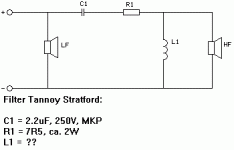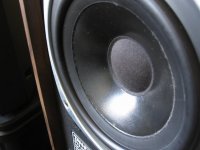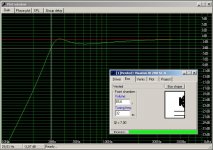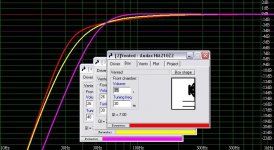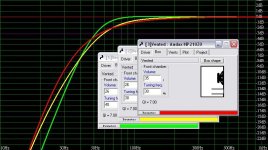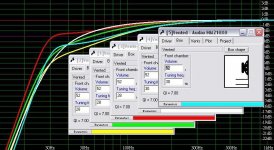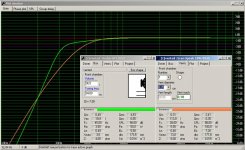Hi, people.
I'm new to this forum. I've been reading a bit here, and, frankly, it's obvious that you guys have LOADS more knowledge and exsperience than I have. My question is this.
I've gotten my hands on a really cheap pair of Tannoy Stratford loudspeakers in reasonable condition. The dustcaps of the woofers were missing, so I've replaced them with new ones. I've also refurbished the filters with new, high quality components and leads. The soundquality has improved greatly - much better imaging and more depth. However, the cabinets are in not-so-good shape and made of 12mm chipboard. I'd like to rebuild them. Some people advised me to use 22mm MDF, others suggested I'd use as thick a sheet of "multiplex" (plywood?) I could get my hands on, because that would sound warmer and it's stiffer to boot, which wood decrease cabinet resonance.
The cabinets have some noticeable resonance between about 150Hz-200Hz - especially with some male vocals. A guy from a high-end audio store advised me to increase the volume of the cabinets to increase bass-extension. I'm not sure how the cabinets are tuned now, but I'm guessing they reach to about 40Hz without roll off. If I would make the cabinets a bit deeper (front to back) and taller and I wanted to tune them to 34Hz, how would that affect port-tuning?
Basically, I have no idea what I'll encounter if I'm going to alter the design. If it's adviseable to keep the design as it is (copy inner dimensions and port length/diameter/placement), please say so. If, on the other hand, it might pay off to increase the cabinet, what would I have to do and pay attention to?
Also, about the filter. There is a coil in there with no indicated value. I've included a schematic of the filter. The crossover is 3.5kHz, according to the manual of the speakers. I've gotten two different measurements, so no useable info: 2.2 and 0.22mH. Which would it be?
Thanks for any advise!
I'm new to this forum. I've been reading a bit here, and, frankly, it's obvious that you guys have LOADS more knowledge and exsperience than I have. My question is this.
I've gotten my hands on a really cheap pair of Tannoy Stratford loudspeakers in reasonable condition. The dustcaps of the woofers were missing, so I've replaced them with new ones. I've also refurbished the filters with new, high quality components and leads. The soundquality has improved greatly - much better imaging and more depth. However, the cabinets are in not-so-good shape and made of 12mm chipboard. I'd like to rebuild them. Some people advised me to use 22mm MDF, others suggested I'd use as thick a sheet of "multiplex" (plywood?) I could get my hands on, because that would sound warmer and it's stiffer to boot, which wood decrease cabinet resonance.
The cabinets have some noticeable resonance between about 150Hz-200Hz - especially with some male vocals. A guy from a high-end audio store advised me to increase the volume of the cabinets to increase bass-extension. I'm not sure how the cabinets are tuned now, but I'm guessing they reach to about 40Hz without roll off. If I would make the cabinets a bit deeper (front to back) and taller and I wanted to tune them to 34Hz, how would that affect port-tuning?
Basically, I have no idea what I'll encounter if I'm going to alter the design. If it's adviseable to keep the design as it is (copy inner dimensions and port length/diameter/placement), please say so. If, on the other hand, it might pay off to increase the cabinet, what would I have to do and pay attention to?
Also, about the filter. There is a coil in there with no indicated value. I've included a schematic of the filter. The crossover is 3.5kHz, according to the manual of the speakers. I've gotten two different measurements, so no useable info: 2.2 and 0.22mH. Which would it be?
Thanks for any advise!
Attachments
Hi,
If you make the cabinet larger keep the original port.
The speaker and port tuning will automatically lower in a bigger box.
As long as you don't change baffle width appreciably any new box should be fine.
I presume the coil is aircored, very little point in changing it.
🙂/sreten.
If you make the cabinet larger keep the original port.
The speaker and port tuning will automatically lower in a bigger box.
As long as you don't change baffle width appreciably any new box should be fine.
I presume the coil is aircored, very little point in changing it.
🙂/sreten.
Hi.
Thanks for your reply. Indeed the coil is, or should be, air cored. However, the entire filter was attached to the input terminals, and all the wires wire wrapped through the coil, to keep them together. I cutted them away as close to the coil as I could manage, and replaced all cables with QED Silver 12. There are some remaining pieces of old cable glued into the core of the coil. I'm not sure if this is in any way comparable to a sort of ferrite or copper core in terms of saturation and distorition.
If I decide to enlarge the cabinet, and thus lower port and speaker tuning, will that affect linearity in one way or another? According to the specs the original cabinet was tuned to 50Hz, but it manages to output 45Hz easily, probably lower. I can't tell exactly how low, since I have no way of measuring. And my listening room is far from ideal. It outputs a tone which I know to be 33Hz, although not easily. If I want to tune to say, 38Hz, how much larger will the cabinet need to be?
I don't want to widen the baffle, just increase depth a little (front to back) and maybe make it taller. I have no idea how much, though... Also, is the location of the port important? Currently it's below and slightly to the right of the woofer. Can it be centered and placed more down? And what about internal bracing? 😕
Darn... This sounds like designing a completely new cabinet... Well, as long as it turns out better than it is now, I don't mind! 🙂
Thanks for any input!
Thanks for your reply. Indeed the coil is, or should be, air cored. However, the entire filter was attached to the input terminals, and all the wires wire wrapped through the coil, to keep them together. I cutted them away as close to the coil as I could manage, and replaced all cables with QED Silver 12. There are some remaining pieces of old cable glued into the core of the coil. I'm not sure if this is in any way comparable to a sort of ferrite or copper core in terms of saturation and distorition.
If I decide to enlarge the cabinet, and thus lower port and speaker tuning, will that affect linearity in one way or another? According to the specs the original cabinet was tuned to 50Hz, but it manages to output 45Hz easily, probably lower. I can't tell exactly how low, since I have no way of measuring. And my listening room is far from ideal. It outputs a tone which I know to be 33Hz, although not easily. If I want to tune to say, 38Hz, how much larger will the cabinet need to be?
I don't want to widen the baffle, just increase depth a little (front to back) and maybe make it taller. I have no idea how much, though... Also, is the location of the port important? Currently it's below and slightly to the right of the woofer. Can it be centered and placed more down? And what about internal bracing? 😕
Darn... This sounds like designing a completely new cabinet... Well, as long as it turns out better than it is now, I don't mind! 🙂
Thanks for any input!
No one?
I just need help some help here, since I'm an utter noob in loudspeaker and filter design.
My question is, what will I run into when I choose to design an new cabinet for the Tannoy speakers I have (Tannoy stratford). I'd like to sqeeuze a little more low end out of them without "hyping" the bass. It should be flat and solid down to the roll of point. And how do I calculate the correct port position and place?
WinISD has a "speakerpower" parameter. What does it mean/do?
Any help is greatly appreciated.
Thanks!
James.
I just need help some help here, since I'm an utter noob in loudspeaker and filter design.
My question is, what will I run into when I choose to design an new cabinet for the Tannoy speakers I have (Tannoy stratford). I'd like to sqeeuze a little more low end out of them without "hyping" the bass. It should be flat and solid down to the roll of point. And how do I calculate the correct port position and place?
WinISD has a "speakerpower" parameter. What does it mean/do?
Any help is greatly appreciated.
Thanks!
James.
Hi,
I suggest you try and obtain the Thiele Small parameters of the
Stratfords bass unit from Tannoy. I've heard they can be quite
helpful in this respect. Post the parameters here.
Without these it would not be wise to attempt a large change
in bass tuning, and it may well be you can simply detune the
port, i.e. making the box bigger would not help significantly.
In this case you could refurbish the cabinets and add internal
bracing, relatively painless compared to building new cabinets.
it may also be the case you could use significantly larger
cabinets with lower tuning, but the parameters are needed.
🙂/sreten.
I suggest you try and obtain the Thiele Small parameters of the
Stratfords bass unit from Tannoy. I've heard they can be quite
helpful in this respect. Post the parameters here.
Without these it would not be wise to attempt a large change
in bass tuning, and it may well be you can simply detune the
port, i.e. making the box bigger would not help significantly.
In this case you could refurbish the cabinets and add internal
bracing, relatively painless compared to building new cabinets.
it may also be the case you could use significantly larger
cabinets with lower tuning, but the parameters are needed.
🙂/sreten.
Hi, Sreten.
Thanks for your reply. I sent an email to Tannoy (hopefully to the right address) and asked them if it was possible to get the needed parameters, or otherwise, if they knew where to find them.
Internal bracing alone probably won't be enough for these speakers. The cabinets look hideous, chips on corners missing, veneer badly damaged, etc. So I'll have to remake them anyhow. The question is whether or not it's worth it to try to improve on the original design. They sound excellent. Especially knowing that, including new filter components, I paid less than 100 Euro's for them. These components are high-quality. Not top-notch, but waaayyyy better than what was originally fitted into the speakers. And they really came to life with these new capacitors, resistors and cables.
With this increased performance in mind, I'd like to see how far I can stretch them.
The included picture was made after when I fitted new dustcaps.
Thanks for your reply. I sent an email to Tannoy (hopefully to the right address) and asked them if it was possible to get the needed parameters, or otherwise, if they knew where to find them.
Internal bracing alone probably won't be enough for these speakers. The cabinets look hideous, chips on corners missing, veneer badly damaged, etc. So I'll have to remake them anyhow. The question is whether or not it's worth it to try to improve on the original design. They sound excellent. Especially knowing that, including new filter components, I paid less than 100 Euro's for them. These components are high-quality. Not top-notch, but waaayyyy better than what was originally fitted into the speakers. And they really came to life with these new capacitors, resistors and cables.
With this increased performance in mind, I'd like to see how far I can stretch them.
The included picture was made after when I fitted new dustcaps.
Attachments
Jamesblond said:Hi.
There are some remaining pieces of old cable glued into the core of the coil. I'm not sure if this is in any way comparable to a sort of ferrite or copper core in terms of saturation and distorition.
Thanks for any input!
Hi,
if its steel wire it could theorectically cause some distortion.
If you use a craft knife you should be able to slit the end of the
insulation and pull out the remaining wire in the core of the cable.
🙂/sreten.
sreten said:Hi,
I suggest you try and obtain the Thiele Small parameters of the
Stratfords bass unit from Tannoy. I've heard they can be quite
helpful in this respect. Post the parameters here.
Without these it would not be wise to attempt a large change
in bass tuning, and it may well be you can simply detune the
port, i.e. making the box bigger would not help significantly.
🙂/sreten.
I've recieved a reply from Tannoy, saying they no longer have the T/S parameters for the 2048 Tannoy bassdriver in their file:
"I am sorry to inform you we no longer have the T/S for the driver(2048) used on the Tannoy Stratford. I have check our archive store and the T/S perameter no longer exist for this model it must have been deleted or distroyed. ".
So I'll have to do without them. I guess I'll leave the internal volume the same, copying heigth and width. I'll make it a tiny bit deeper to compensate for the volume internal bracing takes up. I'll also experiment with two tube lengths, to see whether the change is worth it. WinISD is useless, since I have no T/S parameters.
The next thing I need to worry about is damping. I'll do some reading on this forum to look for a thing or two.
Note to anyone reading this: I you ever come across the T/S parameters of the Tannoy 2048 mid/bass driver used in the Stratford model, please send me an email, and/or post them here.
Thanks!
Hi,
I'd say you could increase internal volume by 25% to 33%,
especially if you are prepared to experiment with port tuning.
Plug your box size and port size into winISD,
what frequency do you get ?
(use any driver it doesn't matter)
🙂/sreten.
I'd say you could increase internal volume by 25% to 33%,
especially if you are prepared to experiment with port tuning.
Plug your box size and port size into winISD,
what frequency do you get ?
(use any driver it doesn't matter)
🙂/sreten.
Hi.
I've input the current dimensions of box and port into WinISD, based on a Visaton W200 mid/bass driver, which has roughly the same dimensions as my current Tannoy 2048 driver. The gain plot I get looks true to the real-life situation. With a 51mm port diameter and 102.7mm port length, I get a tuning of 40.5Hz. Seems pretty probable to me. Inner box dimensions are:
W: 240mm, H: 455mm, D: 240mm. Volume = 26,2 litres. In my listening room, I notice roll-off at around 36Hz.
I also made a model of a 65.6 litre cabinet, tuned around 32Hz, based on the same W200 driver. I posted the plot below.
W: 240mm, H: 855mm; D:320mm. Keeping in mind that in my listening conditions a small boost below 40Hz occurs, this might not be such a good idea, right? The peaks gets boosted even more. When I model with two W200 drivers, the roll off gets very smooth, but the -3dB point moves from 29 to 36Hz.
Any suggestions?
I've input the current dimensions of box and port into WinISD, based on a Visaton W200 mid/bass driver, which has roughly the same dimensions as my current Tannoy 2048 driver. The gain plot I get looks true to the real-life situation. With a 51mm port diameter and 102.7mm port length, I get a tuning of 40.5Hz. Seems pretty probable to me. Inner box dimensions are:
W: 240mm, H: 455mm, D: 240mm. Volume = 26,2 litres. In my listening room, I notice roll-off at around 36Hz.
I also made a model of a 65.6 litre cabinet, tuned around 32Hz, based on the same W200 driver. I posted the plot below.
W: 240mm, H: 855mm; D:320mm. Keeping in mind that in my listening conditions a small boost below 40Hz occurs, this might not be such a good idea, right? The peaks gets boosted even more. When I model with two W200 drivers, the roll off gets very smooth, but the -3dB point moves from 29 to 36Hz.
Any suggestions?
Attachments
Hi,
the visaton drivers is an 8", whilst yours is a 10" ?
if you increase box size by 33% port tuning will drop to 34Hz.
I prefer overdamped alighments, concentrating more on F6 and F10.
This usually works best for deepest bass with room gain.
I've attached an example.
🙂/sreten.
the visaton drivers is an 8", whilst yours is a 10" ?
if you increase box size by 33% port tuning will drop to 34Hz.
I prefer overdamped alighments, concentrating more on F6 and F10.
This usually works best for deepest bass with room gain.
I've attached an example.
🙂/sreten.
Attachments
Hi, sreten.
Thanks for your reply. What dimensions did you use for your model? It seems your model is even smaller than the original Stratford. That has a volume of 26,2 liters. That enlarged by 33% would make 34,93 liters. I'll experiment a little more. The Statford has an 8" driver, although the effective cone diameter is about 5.7".
In understand roomgain depends of the size of the room, and also on the distance between the speakers and the opposite wall. If that distance decreases, the roomgain frequency will move up? Sort of comparable to, or the same as modes? (You must understand I am an utter noob. I've only just begun to take a serious interest in building loudspeakers. I've no idea where to start and there's a gazillion things I want to know 😀 )
Am I correct if I say that f6 and f10 are resp. -6dB and -10dB?
Thanks for your reply. What dimensions did you use for your model? It seems your model is even smaller than the original Stratford. That has a volume of 26,2 liters. That enlarged by 33% would make 34,93 liters. I'll experiment a little more. The Statford has an 8" driver, although the effective cone diameter is about 5.7".
In understand roomgain depends of the size of the room, and also on the distance between the speakers and the opposite wall. If that distance decreases, the roomgain frequency will move up? Sort of comparable to, or the same as modes? (You must understand I am an utter noob. I've only just begun to take a serious interest in building loudspeakers. I've no idea where to start and there's a gazillion things I want to know 😀 )
Am I correct if I say that f6 and f10 are resp. -6dB and -10dB?
Hi,
your final statement is correct.
Also true on room gain. for decent low bass room gain you need
the speakers away fom the floor and both back and side walls.
To me its more dependent on these distances, 2 are variable.
I knew someone who has the 10" version, I forgot there is an 8" version.
Its impossible to guesstimate accurately the parameters of your bass unit.
So I chose a unit at random, I forgot to show the + 33% case.
But the nearest I'd say is likely an efficient Audax unit.
Heres one :
your final statement is correct.
Also true on room gain. for decent low bass room gain you need
the speakers away fom the floor and both back and side walls.
To me its more dependent on these distances, 2 are variable.
I knew someone who has the 10" version, I forgot there is an 8" version.
Its impossible to guesstimate accurately the parameters of your bass unit.
So I chose a unit at random, I forgot to show the + 33% case.
But the nearest I'd say is likely an efficient Audax unit.
Heres one :
Attachments
Hi,
as your binning the boxes you could try double the volume.
cut holes in one top and one bottom and glue together.
close off one port and one driver opening.
you should have 52 liters tuned to 28Hz.
🙂/sreten.
Heres a selection of Audax 8"s that work in 26L tuned to 40Hz
as your binning the boxes you could try double the volume.
cut holes in one top and one bottom and glue together.
close off one port and one driver opening.
you should have 52 liters tuned to 28Hz.
🙂/sreten.
Heres a selection of Audax 8"s that work in 26L tuned to 40Hz
Attachments
I'm confused. 😕
It seems that a larger Xmax has a negative effect on bass performance in small loudspeaker designs. According to a few simulations I ran, you'd need two drivers in a very large cabinet to get some decent sub-bass and a smooth roll-off.
The simulations Sreten posted earlier use an 8" Audax unit with an Xmax of about 4mm. My Tannoy 2048 driver has a basket diameter of 204mm and an effective cone-diameter of 159 mm (half surround to half surround), which would make it a 6.5" driver. I ran a simulation with a 6.5" audax driver with an Xmax of 3.5mm. It gave me a very smooth response down to 32Hz in a 36.5 litre cabinet and port dimensions which are quite similar to the original Tannoy Stratford Design. The 2048 driver has an (estimated) Xmax of about 10mm. So I also ran a simulation with a similar driver (Scan-Speak 18W/8545). I get much less bandwidth and unmanageable port dimensions in the cabinet I want to build, if I want to keep vent mach below 0.10.
The original Stratford is tuned to 50 Hz, with a conciderable bump at 50Hz. My goal in this project is to tame that bump and at the same time stretch bassresponse downwards a little. As can be seen in the attached image, that is possible with small Xmax (32Hz @ -3dB), but with larger Xmax, things get out of hand.
Any ideas? Because I'm at a loss...
It seems that a larger Xmax has a negative effect on bass performance in small loudspeaker designs. According to a few simulations I ran, you'd need two drivers in a very large cabinet to get some decent sub-bass and a smooth roll-off.
The simulations Sreten posted earlier use an 8" Audax unit with an Xmax of about 4mm. My Tannoy 2048 driver has a basket diameter of 204mm and an effective cone-diameter of 159 mm (half surround to half surround), which would make it a 6.5" driver. I ran a simulation with a 6.5" audax driver with an Xmax of 3.5mm. It gave me a very smooth response down to 32Hz in a 36.5 litre cabinet and port dimensions which are quite similar to the original Tannoy Stratford Design. The 2048 driver has an (estimated) Xmax of about 10mm. So I also ran a simulation with a similar driver (Scan-Speak 18W/8545). I get much less bandwidth and unmanageable port dimensions in the cabinet I want to build, if I want to keep vent mach below 0.10.
The original Stratford is tuned to 50 Hz, with a conciderable bump at 50Hz. My goal in this project is to tame that bump and at the same time stretch bassresponse downwards a little. As can be seen in the attached image, that is possible with small Xmax (32Hz @ -3dB), but with larger Xmax, things get out of hand.
Any ideas? Because I'm at a loss...
Attachments
Hi,
You are talking about a hifi speaker not a subwoofer.
In this case running the driver near full Xmax in the low bass is
not really an option as it will grossly overload at other frequencies.
10mm Xmax is a long way, I'd say its 5mm (10mm peak to peak).
Any decent sized port (> 2.5") in a 40L box should be fine.
For more info about high flow flared ports checkout : http://www.users.bigpond.com/bcolliso/index.htm
edit :
also note vent mach depends on the value of Pe you enter.
The difference in the two alignments is due to different Qts.
🙂/sreten.
You are talking about a hifi speaker not a subwoofer.
In this case running the driver near full Xmax in the low bass is
not really an option as it will grossly overload at other frequencies.
10mm Xmax is a long way, I'd say its 5mm (10mm peak to peak).
Any decent sized port (> 2.5") in a 40L box should be fine.
For more info about high flow flared ports checkout : http://www.users.bigpond.com/bcolliso/index.htm
edit :
also note vent mach depends on the value of Pe you enter.
The difference in the two alignments is due to different Qts.
🙂/sreten.
Aahhh, so Xmax is measured one way. I thought it was measured peak to peak. That changes things. In that case I might very well get pretty good results with the design I had in mind.
Then there are a few damping and filter issues I'd like to clear up. But I'm not sure if that is relevant just yet.
I posted in another thread about woodtypes. Supposedly plywood is better suited for Horn tweeters than MDF, because MDF would tame them too much. And MDF would be better suited for smooth, deep bass. With that in mind, I was thinking to make the baffle out of 30mm plywood (22mm + 8mm glued and screwed togehter) and the rest of the cabinet out of 22mm MDF and brace it internally. Dampen the box with bitumen (carpet tiles) glued or tackered to the inside and stuff it with some other material. I'm not sure which one yet. Might work? What do you guys think? Thanks.
Then there are a few damping and filter issues I'd like to clear up. But I'm not sure if that is relevant just yet.
I posted in another thread about woodtypes. Supposedly plywood is better suited for Horn tweeters than MDF, because MDF would tame them too much. And MDF would be better suited for smooth, deep bass. With that in mind, I was thinking to make the baffle out of 30mm plywood (22mm + 8mm glued and screwed togehter) and the rest of the cabinet out of 22mm MDF and brace it internally. Dampen the box with bitumen (carpet tiles) glued or tackered to the inside and stuff it with some other material. I'm not sure which one yet. Might work? What do you guys think? Thanks.
- Status
- Not open for further replies.
- Home
- Loudspeakers
- Multi-Way
- Tannoy Stratford rebuilding and/or retuning
